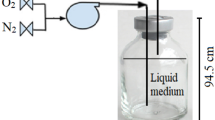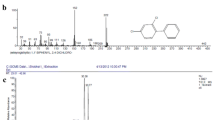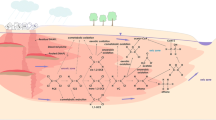Abstract
Burkholderia sp. strain SJ98 (DSM 23195) was previously isolated and characterized for degradation and co-metabolic transformation of a number nitroaromatic compounds. In the present study, we evaluated its metabolic activity on chlorinated nitroaromatic compounds (CNACs). Results obtained during this study revealed that strain SJ98 can degrade 2-chloro-4-nitrophenol (2C4NP) and utilize it as sole source of carbon, nitrogen, and energy under aerobic conditions. The cells of strain SJ98 removed 2C4NP from the growth medium with sequential release of nearly stoichiometric amounts of chloride and nitrite in culture supernatant. Under aerobic degradation conditions, 2C4NP was transformed into the first intermediate that was identified as p-nitrophenol by high-performance liquid chromatography, LCMS-TOF, and GC-MS analyses. This transformation clearly establishes that the degradation of 2C4NP by strain SJ98 is initiated by “reductive dehalogenation”; an initiation mechanism that has not been previously reported for microbial degradation of CNAC under aerobic conditions.




Similar content being viewed by others
References
Apajalahti JH, Salkinoja-Salonen MS (1987) Complete dechlorination of tetrachlorohydroquinone by cell extracts of pentachlorophenol-induced Rhodococcus chlorophenolicus. J Bacteriol 169:5125–5130
Beunink J, Rehm HJ (1990) Coupled reductive and oxidative degradation of 4-chloro-2-nitrophenol by a co-immobilized mixed culture system. Appl Microbiol Biotechnol 34:108–115
Bruhn C, Bayly RC, Knackmuss HJ (1988) The in vivo construction of 4-chloro-2-nitrophenol assimilatory bacteria. Arch Microbiol 150:171–177
Chapman PJ, Hooper DJ (1968) The bacterial metabolism of 2,4-xylenol. Biochem J 110:491–498
Chauhan A, Pandey G, Sharma NK, Paul D, Pandey J, Jain RK (2010) p-Nitrophenol degradation via 4-nitrocatechol in Burkholderia sp. SJ98 and cloning of some the lower pathway genes. Environ Sci Technol 44:3435–3441
Cozza CL, Woods SL (1992) Reductive dechlorination pathway for substituted benzenes: a correlation with electronic properties. Biodegradation 58:1385–1387
European Economic Community (1982) Communication from the commission to the council on dangerous substances which might be included in list I of council directive 76/464/EEC. European Economic Community, Brussels
Ferreira MIM, Marchesi JR, Jansses DB (2008) Degradation of 4-fluorophenol by Arthrobacer sp. strain IF1. Appl Microbiol Biotechnol 78:709–717
Fetzner S (1998) Bacterial dehalogenation. Appl Microbiol Biotechnol 50:633–657
Ghosh A, Khurana M, Chauhan A, Takeo M, Chakraborti AK, Jain RK (2010) Degradation of 4-nitrophenol, 2-chloro-4-nitrophenol, and 2,4-dinitrophenol by Rhodococcus imtechensis strain RKJ300. Environ Sci Technol 44:1069–1077
Haigler BE, Nishino SF, Spain JC (1994) Biodegradation of 4-methyl-5-nitrocatechol by Pseudomonas sp. strain DNT. J Bacteriol 176:3433–3437
Janssen DB, Oppentocht JE, Poelarends GJ (2001) Microbial dehalogenation. Curr Opin Biotechnol 12:254–258
Kadiyala V, Spain JC (1998) A two component monooxygenase catalyzes both the hydroxylation of p-nitrophenol and the oxidative release of nitrite from 4- nitrocatechol in Bacillus sphaericus JS905. Appl Environ Microbiol 64:2479–2484
Katsivela E, Wray V, Pieper DH, Wittich RM (1999) Initial reactions in the biodegradation of 1-chloro-4-nitrobenzene by a newly isolated bacterium, strain LW1. Appl Environ Microbiol 65:1405–1412
Lenke H, Knackmuss HJ (1996) Initial hydrogenation and extensive reduction of substituted 2,4-dinitrophenols. Appl Environ Microbiol 62:784–790
Linch AL (1974) Biological monitoring for industrial exposure to cyanogenic aromatic nitro and amino compounds. Am Ind Hyg Assoc J 35:426–432
Manickam N, Mau M, Schlomann M (2006) Characterization of the novel HCH degrading strain, Microbacterium sp. ITRC1. Appl Microbiol Biotechnol 69:580–588
Mohn WW, Tiedje JM (1992) Microbial reductive dehalogenation. Microbiol Rev 56:482–507
NC-IUB (1979) Units of enzyme activity. Eur J Biochem 97:319–320
Nishino SF, Spain JC (1993) Degradation of nitrobenzene by a Pseudomonas pseudoalcaligenes. Appl Environ Microbiol 59:2520–2525
Pandey G, Chauhan A, Samanta SK, Jain RK (2002) Chemotaxis of a Ralstonia sp. SJ98 toward co-metabolizable nitroaromatic compounds. Biochem Biophys Res Commun 299:404–409
Pandey G, Paul D, Jain RK (2003) Branching of o-nitrobenzoate degradation pathway in Arthrobacter protophormiae RKJ100: identification of new intermediates. FEMS Microbiol Lett 229:231–236
Romanov V, Hausinger RP (1996) NADPH-dependent reductive ortho dehalogenation of 2,4- dichlorobenzoic acid in Corynebacterium sepedonicum KZ-4 and Coryneform bacterium strain NTB-1 via 2,4-dichlorobenzoyl coenzyme A. J Bacteriol 178:2656–2661
Samanta SK, Bhushan B, Chauhan A, Jain RK (2000) Chemotaxis of a Ralstonia sp. SJ98 toward different nitroaromatic compounds and their degradation. Biochem Biophys Res Commun 269:117–123
Schenzle A, Lenke H, Spain JC, Knackmuss HJ (1999) Chemoselective nitro group reduction and reductive dechlorination initiate degradation of 2-chloro-5-nitrophenol by Ralstonia eutropha JMP134. Appl Environ Microbiol 65:2317–2323
Schlomann M, Schmidt E, Knackmuss HJ (1990) Different types of dienelactone hydrolase in 4-fluorobenzoate-utilizing bacteria. J Bacteriol 172:5112–5118
Shen JM, Chen ZL, Xu ZZ, Li XY, Xu BB, Qi F (2008) Kinetics and mechanism of degradation of p-chloronitrobenzene in water by ozonation. J Hazard Mater 152:1325–1331
Shimizu M, Yasui T, Matsumoto N (1983) Structural specificity of aromatic compounds with special reference to mutagenic activity in Salmonella typhimurium—a series of chloro- or fluoro-nitrobenzene derivatives. Mutat Res 116:217–238
Spain JC (1995) Biodegradation of nitroaromatic compounds. Annu Rev Microbiol 49:523–555
Spain JC, Nishino SF (1987) Degradation of 1,4-dichlorobenzene by Pseudomonas sp. Appl Environ Microbiol 53:1010–1019
Steinwandter H (1987) Research in environmental pollution. II. Determination of polychlorinated nitrobenzenes (PCNB’s) in main river fish. Fresenius Z Anal Chem 326:139–141
Struijs J, Rogers JE (1989) Reductive dehalogenation of dichloroanilines by anaerobic microorganisms in fresh and dichlorophenol- acclimated pond sediment. Appl Environ Microbiol 55:2527–2531
Susarla S, Masunaga S, Yonezawa Y (1996) Transformations of chloronitrobenzenes in anaerobic sediment. Chemosphere 32:967–977
Symons ZC, Bruce NC (2006) Bacterial pathways for degradation of nitroaromatics. Nat Prod Rep 23:845–850
van den Tweel WJJ, Kok JB, de Bont JAM (1987) Reductive dechlorination of 2,4-dichlorobenzoate to 4-chlorobenzoate and hydrolytic dehalogenation of 4-chloro-, 4-bromo-, and 4-iodobenzoate by Alcaligenes denitrificans NTB-1. Appl Environ Microbiol 53:810–815
van der Meer JR (1997) Evolution of novel metabolic pathways for the degradation of chloroaromatic compounds. Antonie Leeuwenhoek 71:159–178
Wu JF, Jiang CY, Wang BJ, Ma YF, Liu ZP, Liu SJ (2006) Novel partial reductive pathway for 4-chloronitrobenzene and nitrobenzene degradation in Comamonas sp. strain CNB-1. Appl Environ Microbiol 72:1759–1765
Yoshida T (1993) Determination of p-chloronitrobenzene and its metabolites in urine by reversed-phase high-performance liquid chromatography. J Chromatogr 613:79–88
Yurawecz MP, Puma BJ (1983) Identification of chlorinated nitrobenzene residues in Mississippi River fish. J Assoc Off Anal Chem 66:1345–1352
Acknowledgments
This study was supported in part by the Department of Biotechnology (DBT), India and the Council for Scientific and Industrial Research (CSIR), India. We are thankful to Ms. Mahima Pant and Mr. Vivek Mahajan for their technical help during this study. JP, AC, and PKA acknowledge the research scholarship provided by CSIR, India.
Author information
Authors and Affiliations
Corresponding author
Rights and permissions
About this article
Cite this article
Pandey, J., Heipieper, H.J., Chauhan, A. et al. Reductive dehalogenation mediated initiation of aerobic degradation of 2-chloro-4-nitrophenol (2C4NP) by Burkholderia sp. strain SJ98. Appl Microbiol Biotechnol 92, 597–607 (2011). https://doi.org/10.1007/s00253-011-3254-y
Received:
Revised:
Accepted:
Published:
Issue Date:
DOI: https://doi.org/10.1007/s00253-011-3254-y




